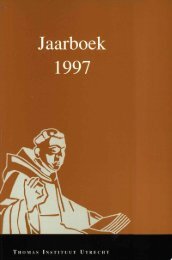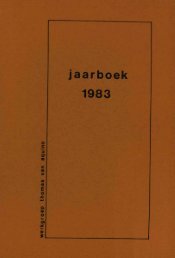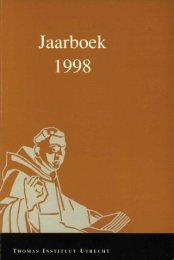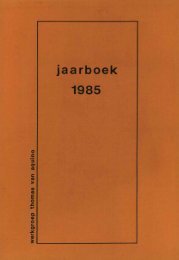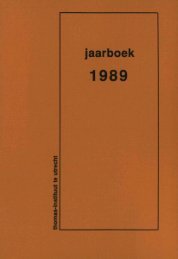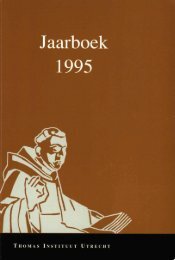Jaarboek Thomas Instituut 2006 - Thomas Instituut te Utrecht
Jaarboek Thomas Instituut 2006 - Thomas Instituut te Utrecht
Jaarboek Thomas Instituut 2006 - Thomas Instituut te Utrecht
You also want an ePaper? Increase the reach of your titles
YUMPU automatically turns print PDFs into web optimized ePapers that Google loves.
20 HENK J.M. SCHOOT<br />
to Jesus: the first part to his divinity ("Lord God of Sabaoth, heaven<br />
and earth are full of your glory"), and the second to his humanity<br />
("Blessed is he who comes in the name of the Lord,,).36<br />
Now, if Christ as a person has both a divine and human<br />
nature, then some words have a double significance. And the<br />
significance cannot be equivocal or ambiguous, because this would<br />
jeopardize the unity of Christ's person. So, for example, the words<br />
'knowledge' and 'wisdom' have a double significance in <strong>Thomas</strong>'<br />
vision, when they are said about Christ. There is reference to both<br />
divine and human knowledge and wisdom. The same is true of<br />
'holy'. <strong>Thomas</strong> makes a clear distinction between crea<strong>te</strong>d and<br />
uncrea<strong>te</strong>d holiness. Uncrea<strong>te</strong>d holiness belongs to the divine nature,<br />
and has belonged to Christ from e<strong>te</strong>rnity. Crea<strong>te</strong>d holiness, however,<br />
is worthy of some discussion. The discussion has to do with the<br />
nature of Christ's conception and birth. From his conception, Christ<br />
has also been holy in his human nature, and thus possesses a crea<strong>te</strong>d<br />
holiness. Thus, in his person, Christ uni<strong>te</strong>s holiness as sovereignty,<br />
inaccessibility and hidden-ness on one hand, and holiness as a<br />
connection with and dedication to God on the other. G.-L. Müller<br />
says, in all simplicity, that the Christian faith breaks through the<br />
heathen distinction between sacred and profane." This breakthrough<br />
takes place in Christ. In him heaven and earth come together. "By<br />
the mys<strong>te</strong>ry of this wa<strong>te</strong>r and wine may we come to share in the<br />
divinity of Christ, who humbled himself to share in our humanity",<br />
as the deacon prays when preparing the wine during Mass. This<br />
precisely expresses the holiness of Christ.<br />
36 STh III, q. 83 a. 4 c, 4 SN 8.2.4.3 expositio <strong>te</strong>xtus (Moos nr. 285).<br />
Because, as he makes clear elsewhere, <strong>Thomas</strong> regards the three-fold 'holy'<br />
in the scriptures as a reference to the mys<strong>te</strong>ry of the Trinity, he sees the<br />
Sanctus as a summary of the whole faith (STh II-II, q. 171, a. 3 c; In Isaiam<br />
6, lectio I).<br />
37 See loc. cit. in LThK (footno<strong>te</strong> 28). For a similar thought, but from a<br />
pro<strong>te</strong>stant theologian, see John Webs<strong>te</strong>r, Holiness, London 2003.



